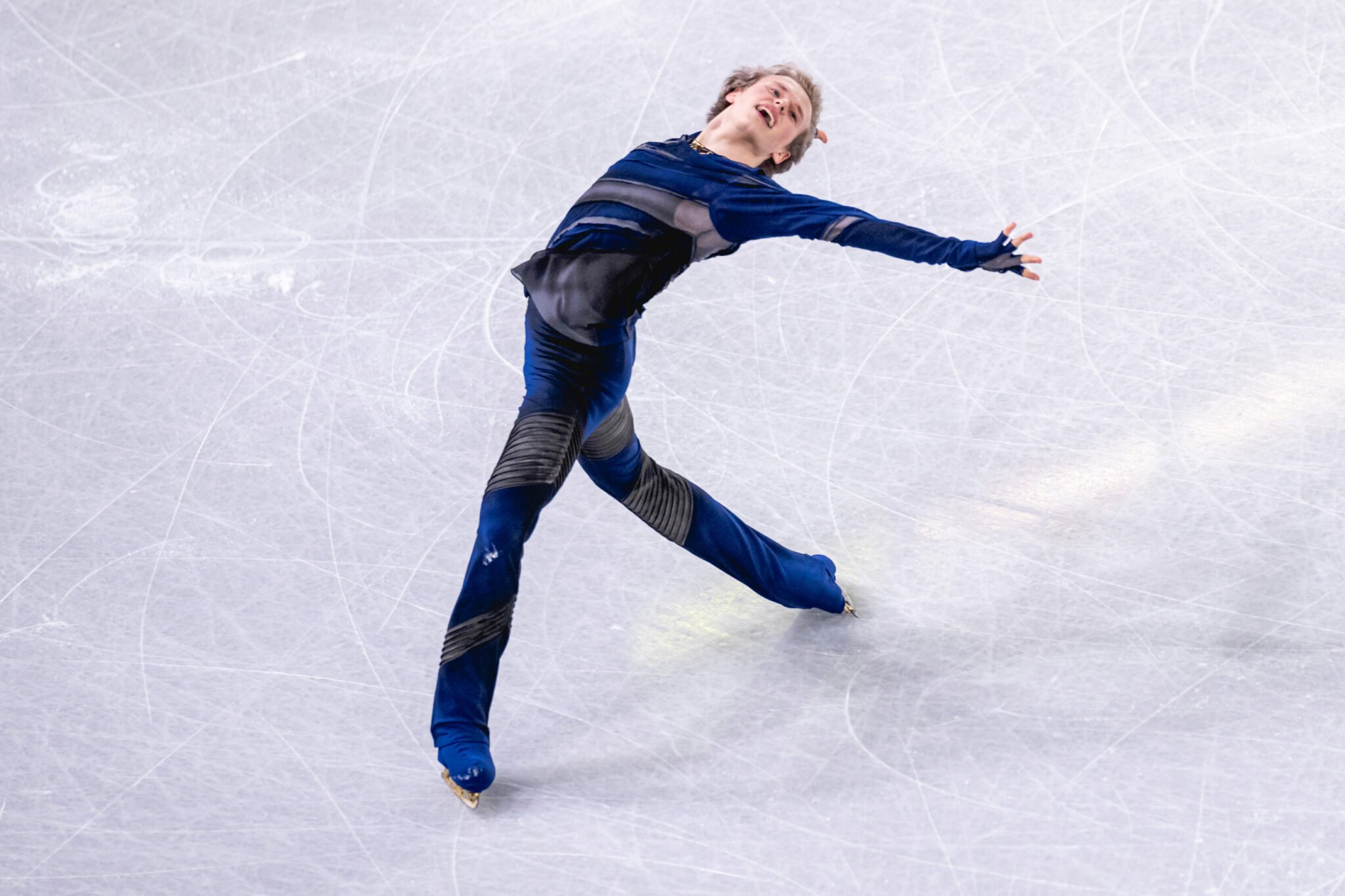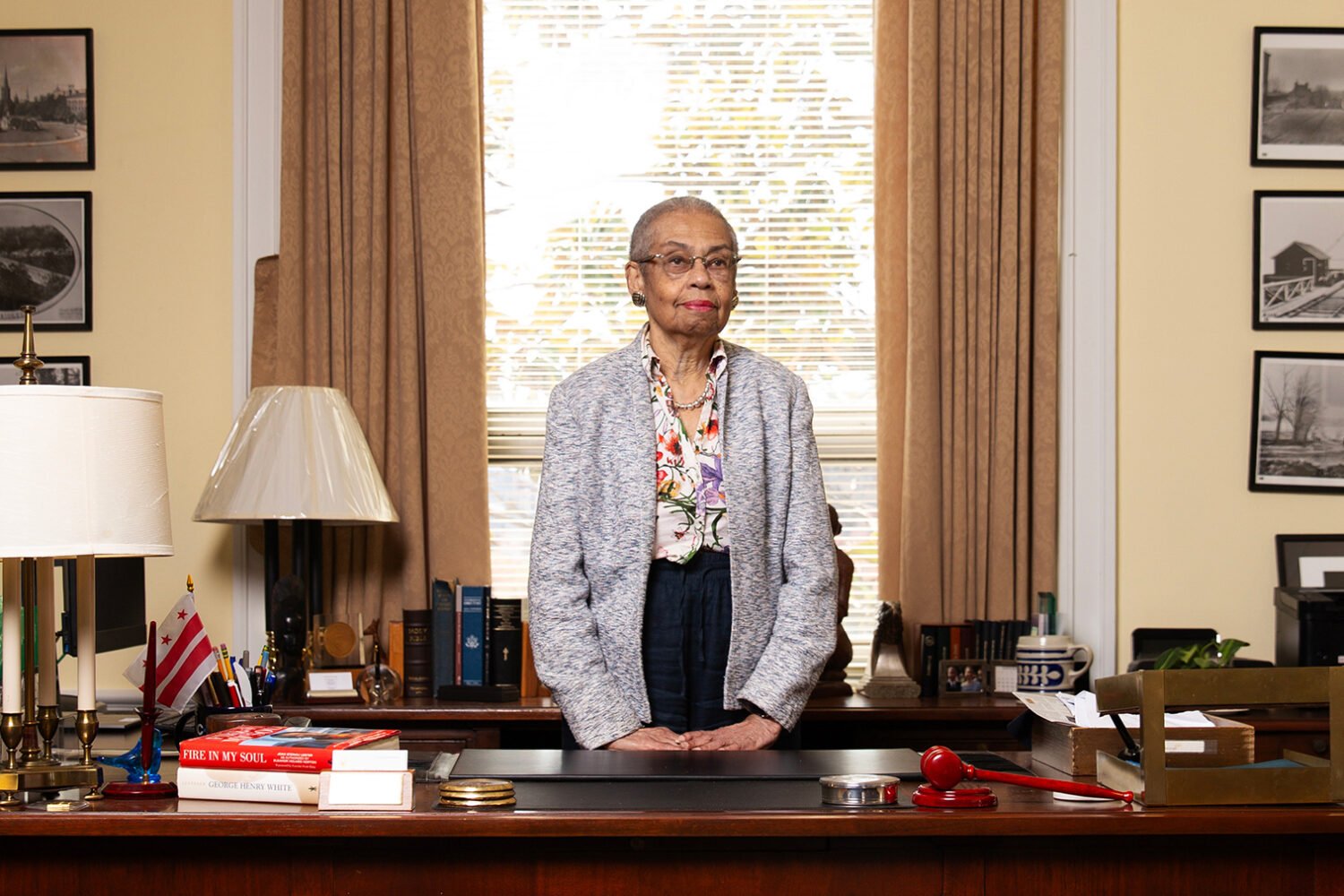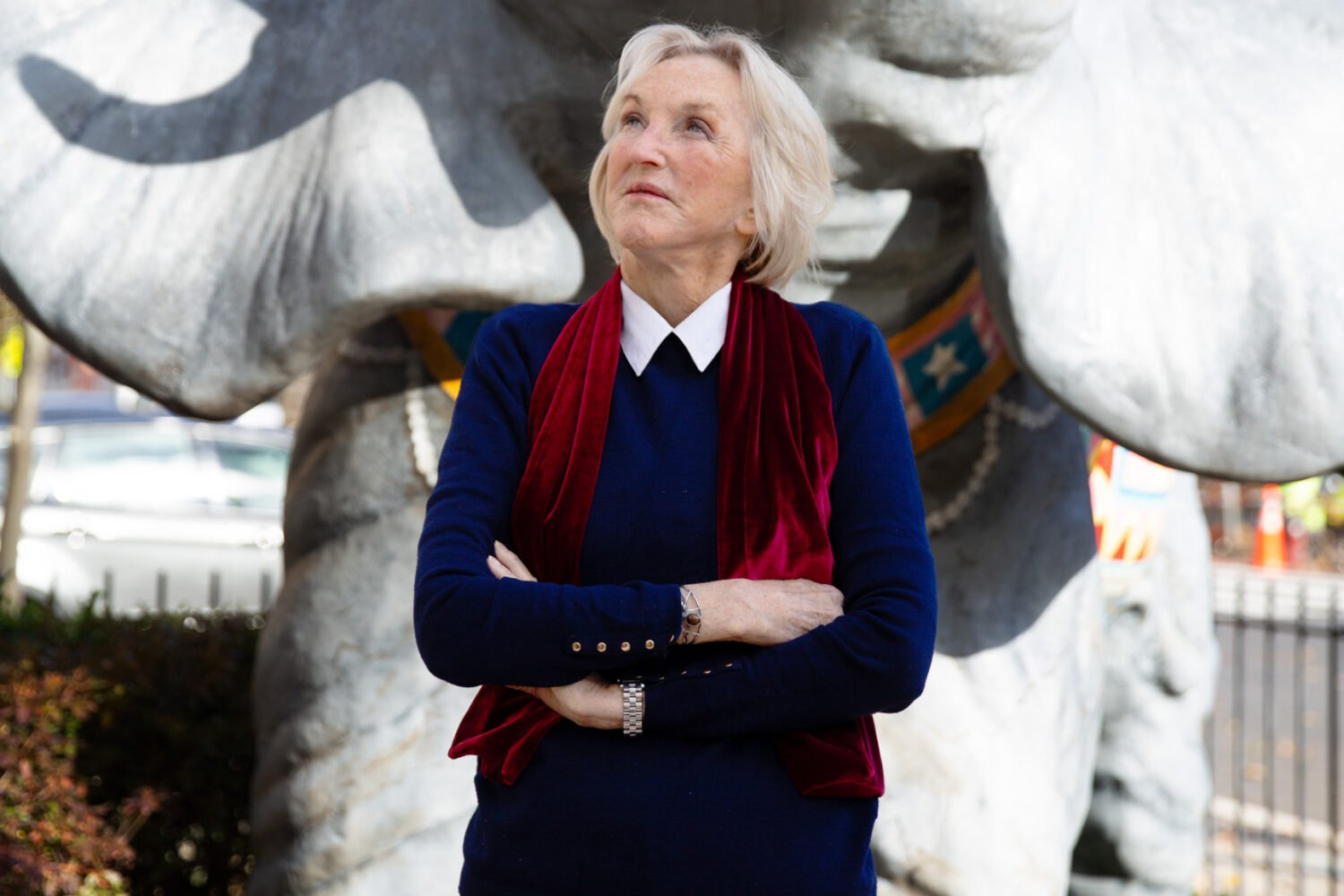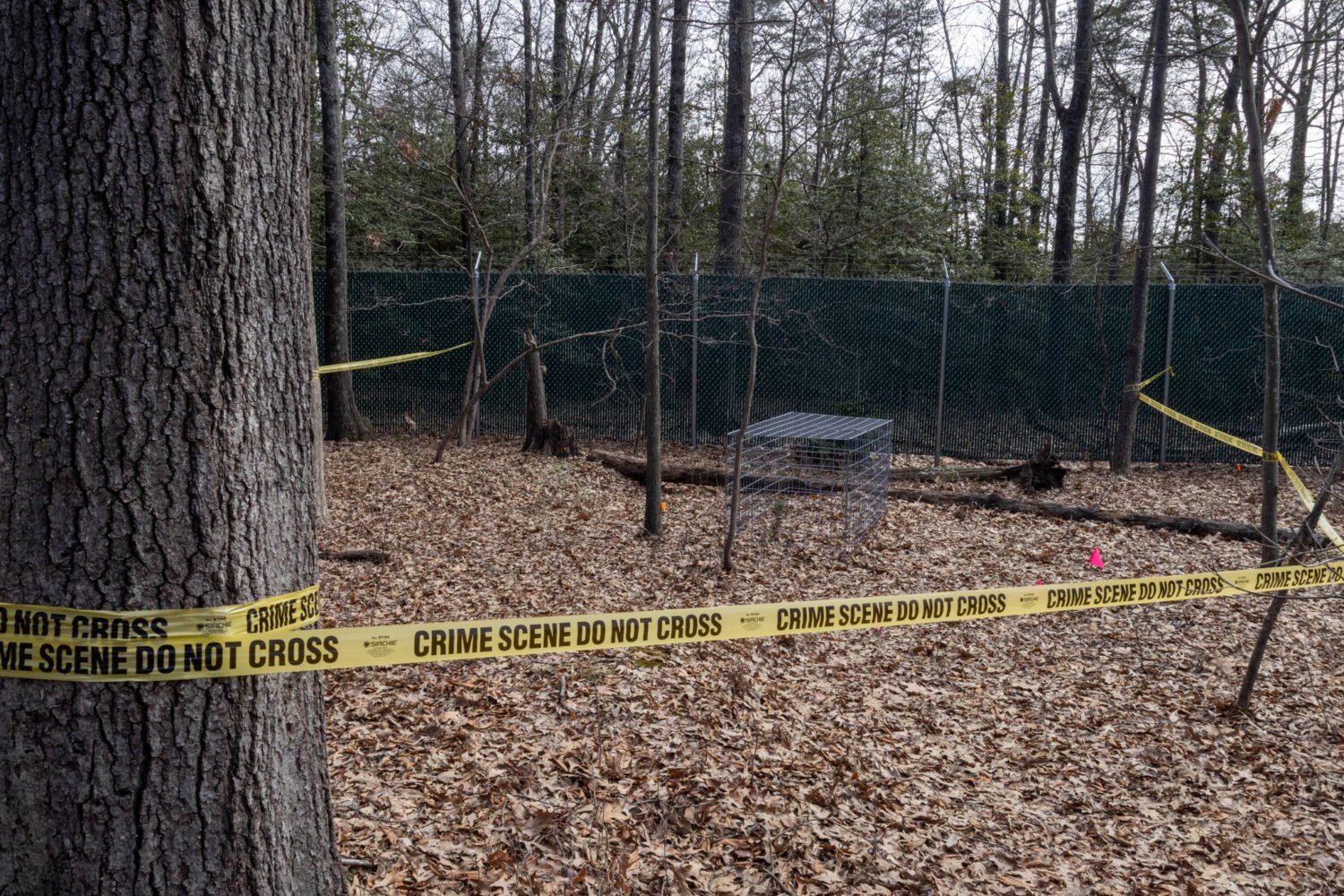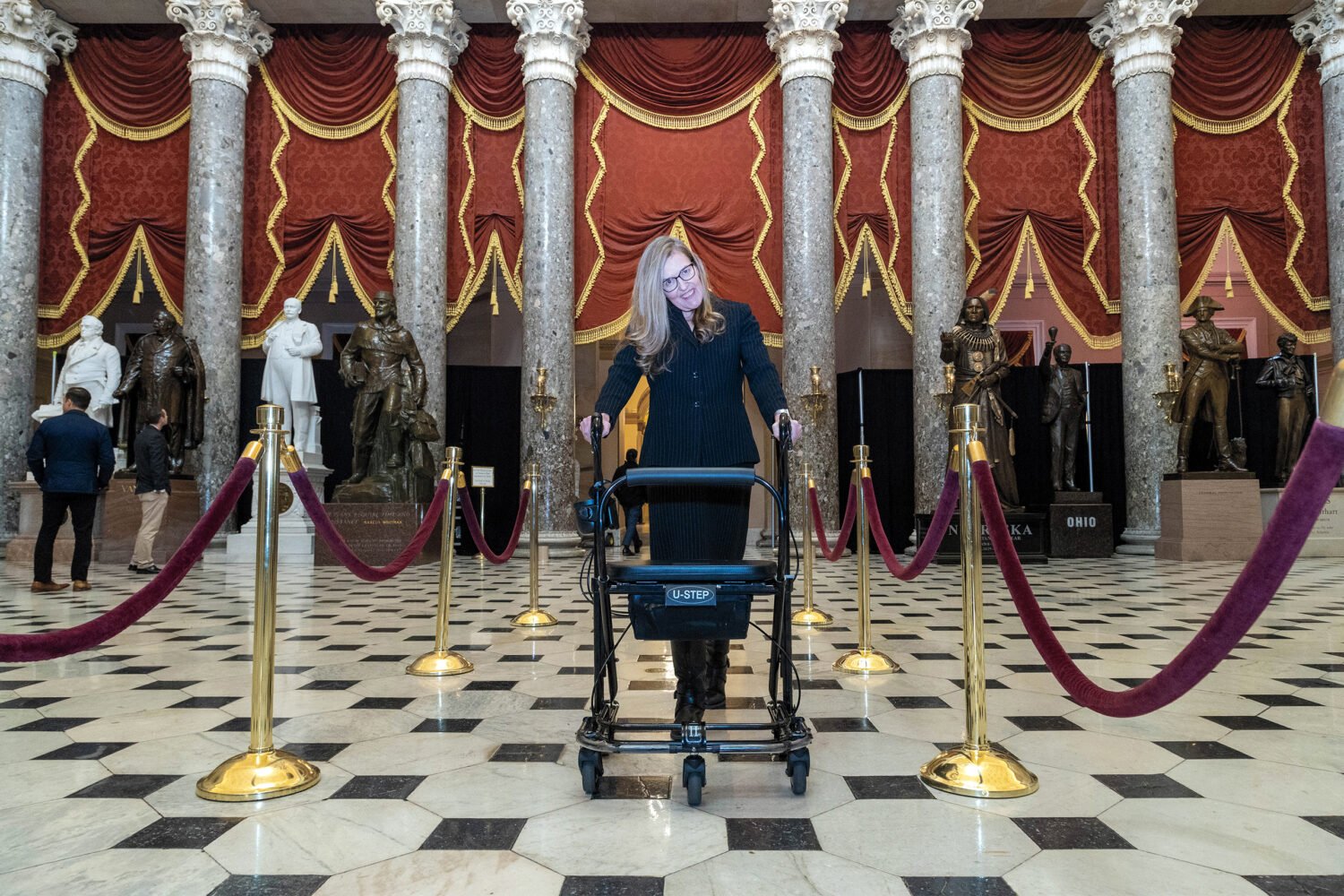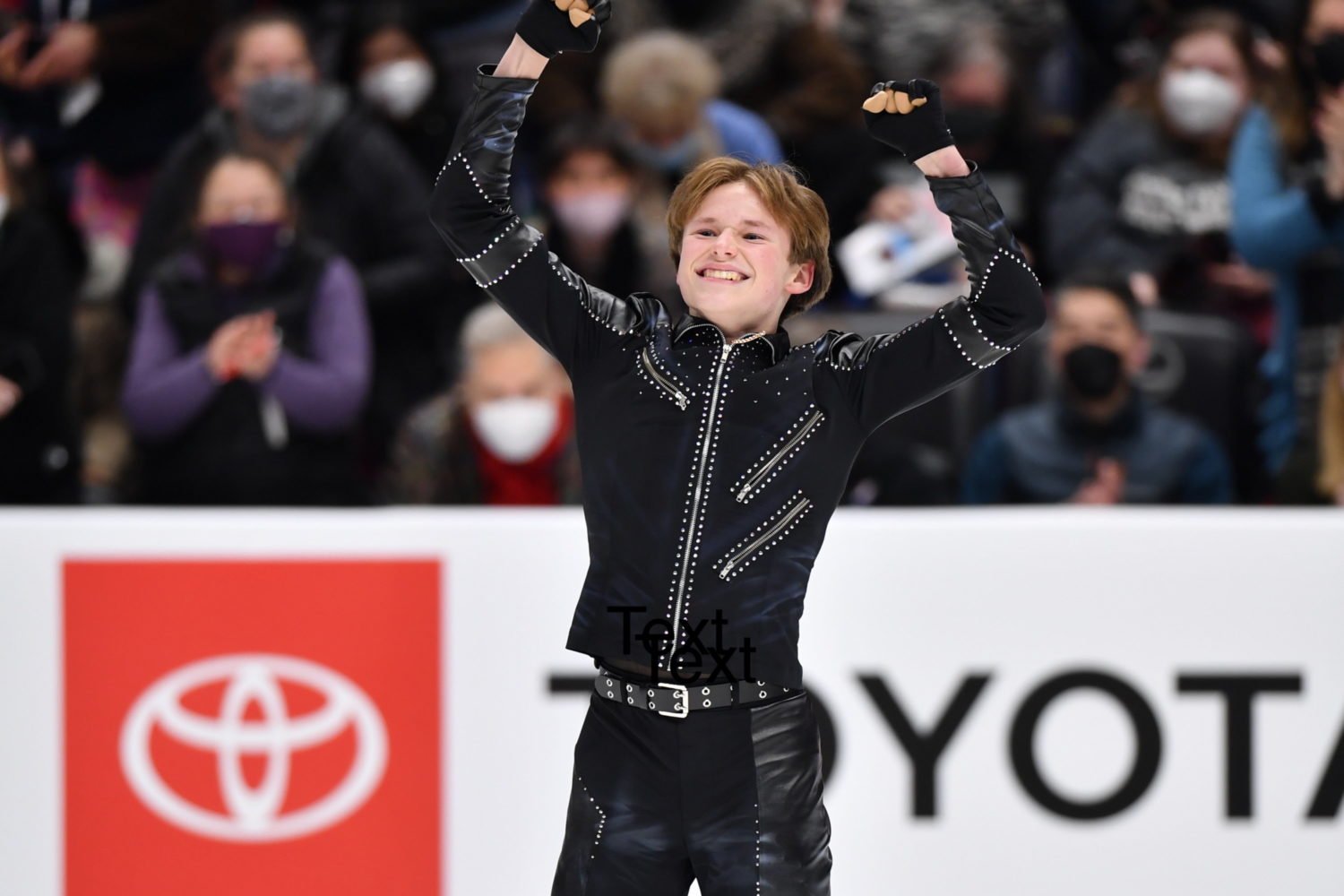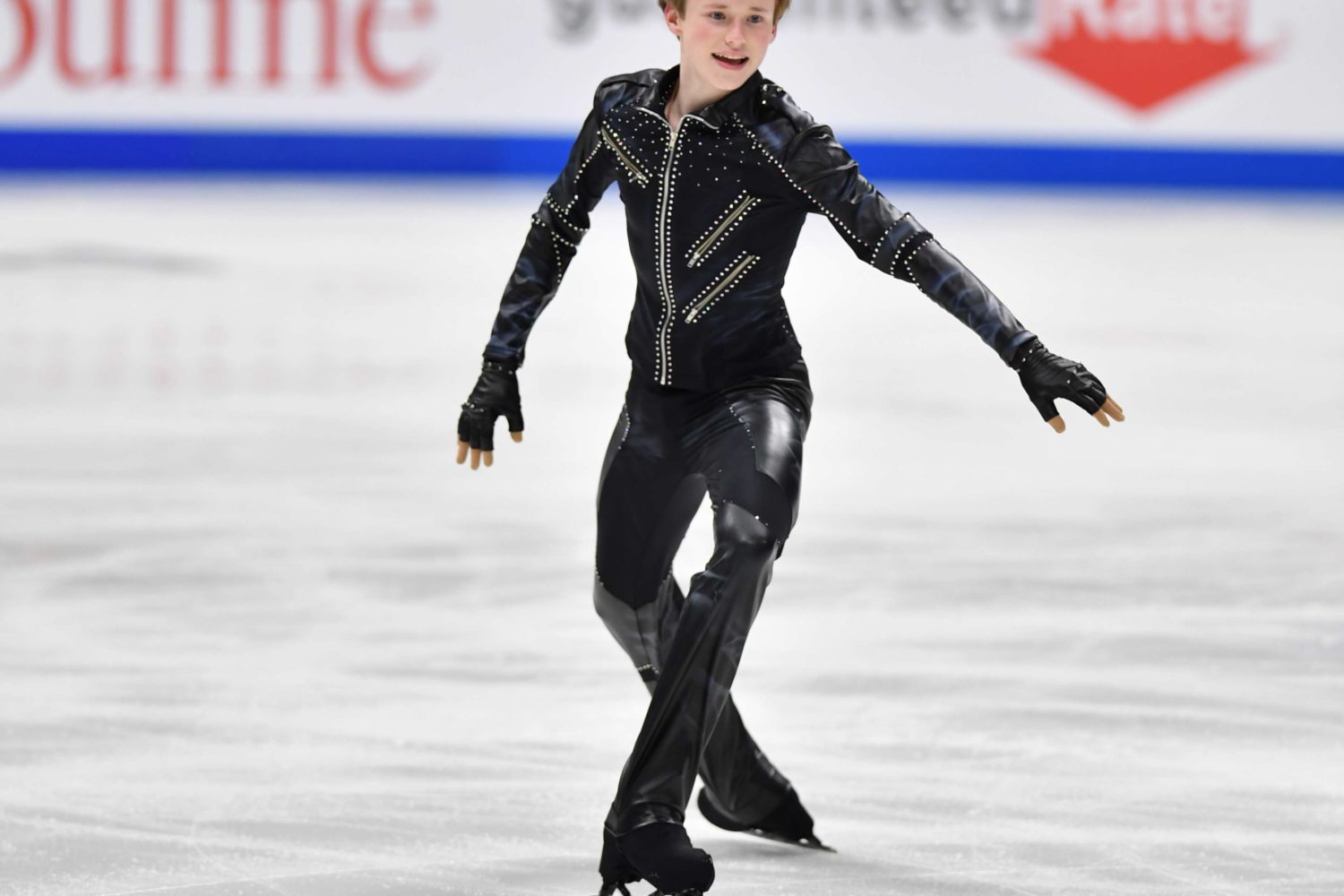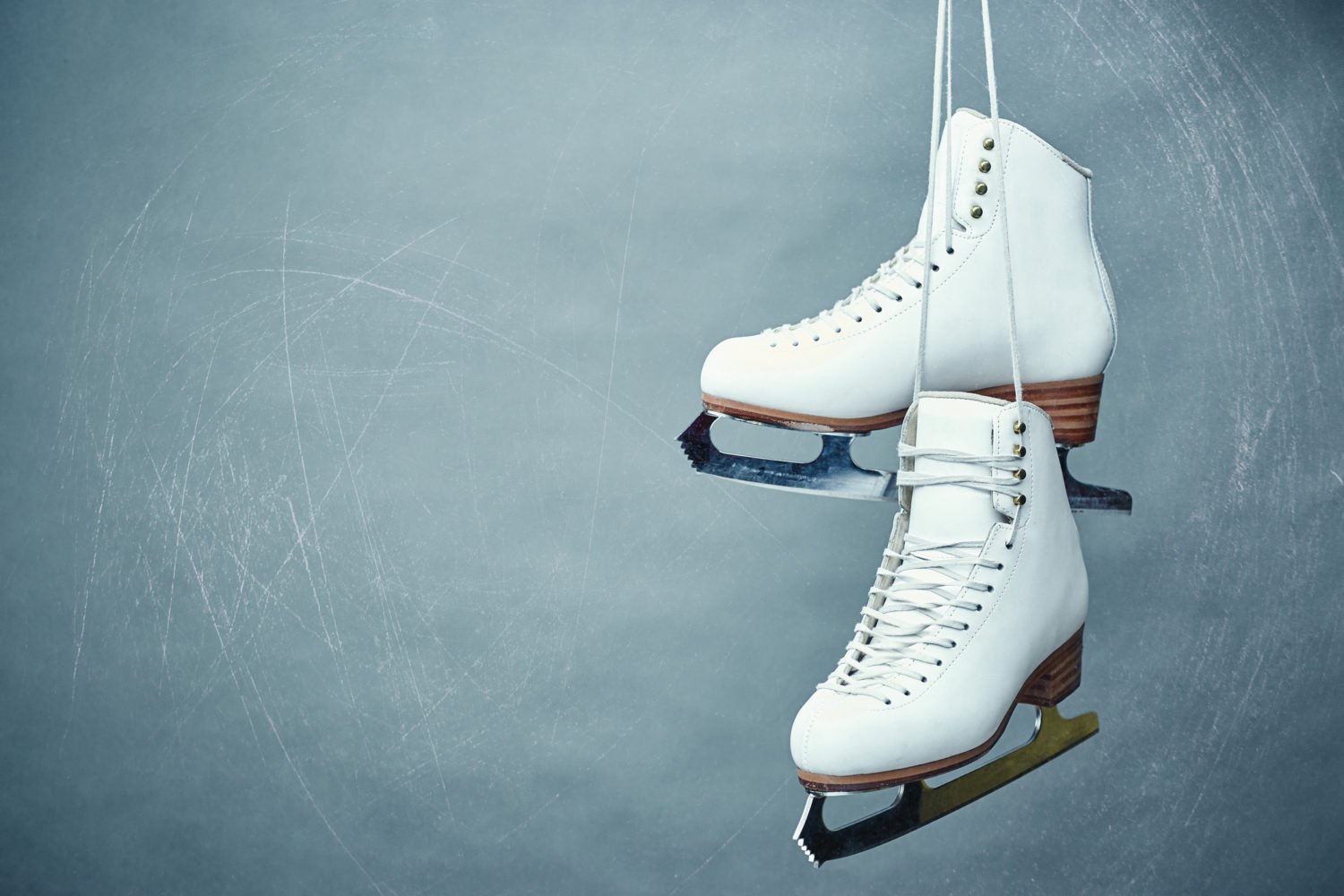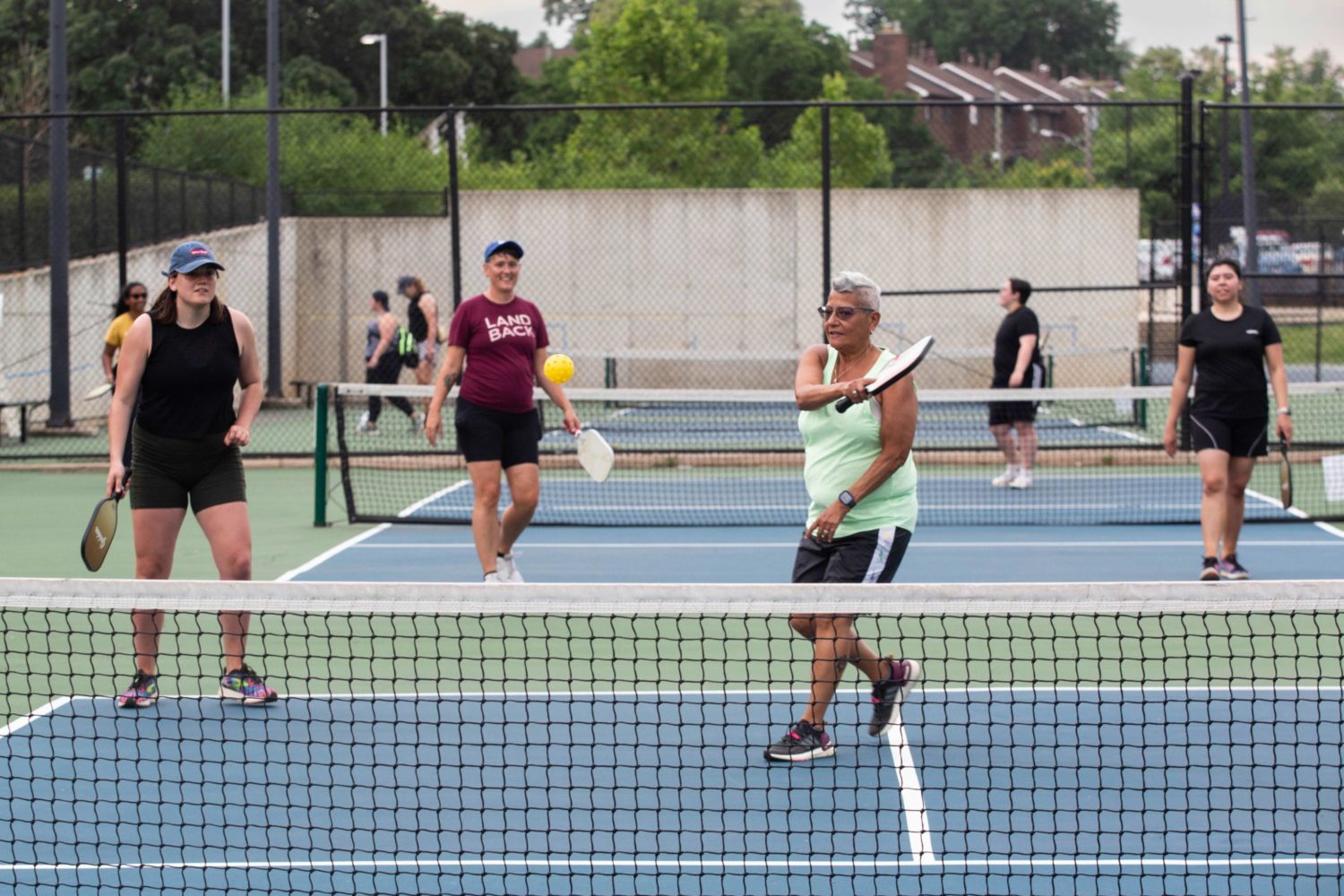The virtual battles waged in the online video games Fortnite and Valorant hardly constitute holy wars. But every so often, the sight of a certain screen name—“Quadg0d,” with the number replacing the vowel—can inspire fellow players to acknowledge a self-proclaimed deity in their midst.
“I’ve been really impressed,” says Ilia Malinin, none other than the Quadg0d himself. “Especially on the East Coast servers, a lot of random people will be like, ‘Omigosh, you’re that figure skater.’ ”
If anybody deserves such a title, it’s Malinin. A lifelong Northern Virginia resident and current George Mason University student, the 20-year-old is taking his sport to new heights—literally. In late January, Malinin ran away with his third straight gold in men’s singles at the United States Figure Skating Championships, a feat matched by only two other skaters since the turn of the century. He’s the favorite to capture a second consecutive world title in Boston in early March and should enter next year’s Winter Olympics in Milan-Cortina in the same position.
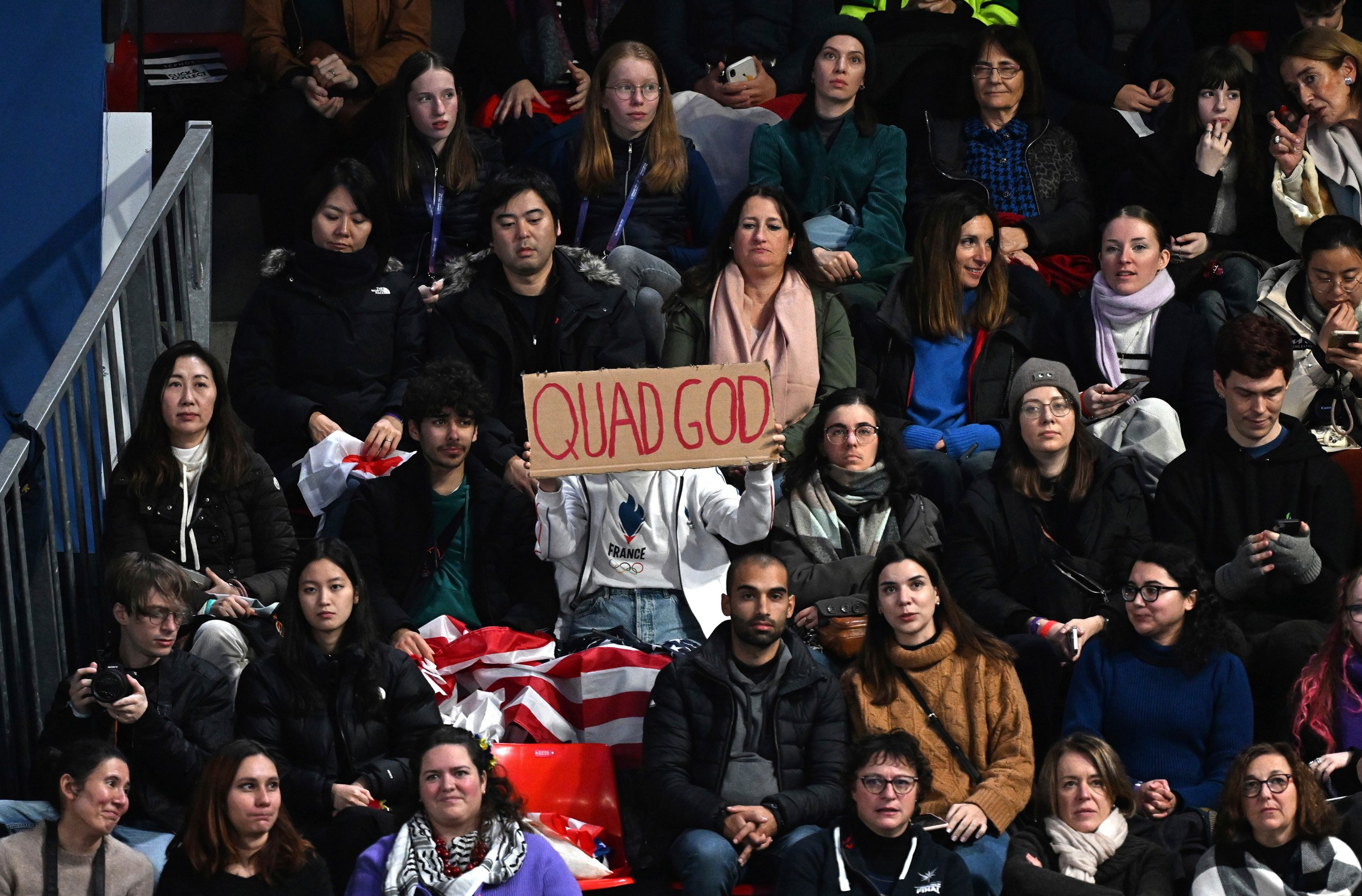
What sets Malinin apart isn’t just his victories. It’s the way he’s earned them, exhibiting unprecedented skill at quadruple jumps—the spinning, soaring, spectacular flights that require at least four midair rotations and have already vaulted him into figure-skating history. He’s the only skater ever to successfully pack all six globally ratified quad jumps into a single free-skate program, a feat that helped him repeat as champion of the International Skating Union’s Grand Prix last December. He’s also the only skater to stick the quad Axel—universally regarded as the toughest of those six jumps—in competition. While few others have dared to attempt that jump, Malinin has pulled it off with perfect rotation ten times since 2022, most recently during his free skate at the US championships.
All in all, not bad for someone who graduated from George C. Marshall High School in 2023—and just got around to obtaining his driver’s license a little over a year ago.
It’s a special person who can break the mold of figure skating. Not just because they win but because they change the whole sport.
“Those are things I never thought I’d see in my lifetime,” says NBC commentator and retired skater Johnny Weir. “It’s a special person who can break the mold of figure skating and really become a legend. Not just because they win but because they change the whole sport.”
Malinin seems well on his way to doing just that—helping to further a so-called “quad revolution,” in which skaters are increasingly attempting spectacular, physically punishing jumps once considered too difficult and dangerous. But his ultimate goal is even loftier. In the US, figure skaters have rarely achieved stardom outside their sport. Some, such as Olympians Brian Boitano and Michelle Kwan, have become famous, but almost wholly for their on-ice accomplishments. Malinin believes he can execute a different sort of leap.
“I think in the past, my sole focus was to be a skater and really be successful at skating,” he says. “Now I’m trying to become more than just a skating celebrity. I want to be one of the top celebrities in the world—like Cristiano Ronaldo, [Lionel] Messi, Dwayne Johnson. I want to be on that level.”
n the beginning, before the Quadg0d, there was Lutzboy.
During an illustrious career that featured a pair of Olympic appearances for Uzbekistan in 1998 and 2002, Russian-born Tatiana Malinina was particularly famous for her triple Lutz. Named for its inventor, Austrian skater Alois Lutz, the jump is especially “tricky because the takeoff is from the outside edge,” says Tatjana Flade, a journalist from Germany who has covered figure skating for more than three decades. “Many skaters don’t have a clean Lutz because their edge is not very clean on the outside.”
Years later, when it came time for Malinina’s eldest child to choose a social-media handle, young Ilia opted to pay homage to her. “I had her technique, and everyone was saying my Lutz was really good, so that’s what the user name was: Lutzboy,” says Malinin, who was born in 2004.
Initially, Malinina and husband Roman Skorniakov—also a two-time Olympian for Uzbekistan in Nagano and Salt Lake City—balked at the idea of training Ilia to follow in their skate-steps. They introduced him to the ice early on, with Ilia taking his first strides around age six, the same as Malinina once did under the tutelage of her father, a figure-skating coach in Russia. But their experience as elite competitors made them wary of pushing any further. “This takes so much time, dedication, a lot of sacrificing, so much hard work,” Malinina told ISU commentator Ted Barton in a video interview late last year. “And we thought maybe we want him to experience [a] different life than we had.”
This hands-off approach was perfectly fine with their son, at least for a bit. Rather than drill his edges or hone his takeoffs, Malinin preferred to freestyle at Reston’s SkateQuest, where both his parents work as coaches. “I’d just play different music over the loudspeakers and try to come up with random programs and enjoy skating for what it is,” he says. “It was just a fun hobby. I wasn’t thinking about doing it professionally.”
That changed quickly. Representing the Washington Figure Skating Club in the juvenile boys’ division at the 2015 US Figure Skating Championships, a ten-year-old Malinin placed ninth out of 12 entrants. The following year—while taking a break from his studies at public school in Fairfax to attend—he won gold. In 2020, he made his World Junior Championships debut in Tallinn, Estonia. It was there that Flade, the German journalist, first watched him compete.
“There were three Americans, and all three were the kids of former skaters,” Flade says. “He was the smallest of them, and he finished the lowest. But still he stood out, because you could see he was very confident.” Even after placing a middling 16th, Malinin expressed high hopes for his future during a post-skate interview with Flade and other journalists. “I remember vividly, we asked what his goals were, and he said that he’d like to make the 2022 Olympic team,” Flade says.
Seven months later, kicking off the season’s ISU Grand Prix at the 2020 Skate America event in Las Vegas, Malinin stuck his first two sanctioned quadruple jumps—the quad toe loop and the quad Salchow—in his senior debut. It was enough to motivate him to ditch @Lutzboy in favor of something unabashedly aspirational. “Everyone kind of got angry at me, like, ‘Why’d you name yourself Quadg0d? You only landed two quads,’ ” he says. “And I was like, ‘Well, I guess now it’s time for me to land the rest of them.’ The username was my motivation.”
More motivation arrived in early 2022 when a 17-year-old Malinin earned a surprise silver medal in the US Championships in Nashville, positioning himself for a possible spot on Team USA for the Beijing Olympics. Soon after, however, he was informed that the US would be bringing three veterans—Nathan Chen, Vincent Zhou, and Jason Brown—and that he’d be an alternate. At the time, Malinin says, he was “pretty, pretty pissed off with myself and annoyed,” blaming his omission on previous competition that season in which he skated particularly poorly.
Looking back, however, he sees his omission as a blessing in disguise: “I think that if I went to the Olympics, then I would not be where I am now. Not going really pushed me to view the sport a different way, and to really push my own physical and mental limits of where I can take this.”
eir first saw Malinin skate in person in spring 2016, at an exhibition Weir was hosting at his home rink in Wilmington, Delaware. “He was already doing triple Axels, which was so impressive,” Weir says of Malinin, then 12. “This fearless bravery [with which] he flies around the ice and hurls himself into the air—he had that then, and he still has that quality now.”
Given the intense physical and emotional tension that accompanies every jump—one missed edge, one under- or over-rotation, one failed landing and a skater’s score goes kaput—Malinin’s attitude is rare. “It’s a hard thing to be in a sport that’s so serious and have everything you’ve done come down to six minutes and still keep that playful frivolity,” says Weir, referring to the combined length of a skater’s short (two minutes) and long (four) programs. “It makes him an enchanting performer.”
It’s a hard thing to be in a sport that’s so serious and have everything you’ve done come down to six minutes and still keep that playful frivolity.
Malinin can seem almost casual as he goes about his history-making business. His self-described “lucky charm” is a soccer ball that he ritually juggles like a Hacky Sack as a warm-up. He has no problem peeking at the monitors backstage during competitions—in fact, he enjoys watching fellow skaters, even when he has yet to take the ice himself. “Not everyone’s like that,” Flade says. “Some even cover their ears so they don’t hear the other scores.” It also isn’t unusual to see Malinin lip-synching in the middle of his programs as he loses himself in the soundtrack—just as he used to back at SkateQuest as a kid. “When I’m able to get into that zone, then I’m able to really let all my emotions go,” Malinin says. “That helps me perform better.”
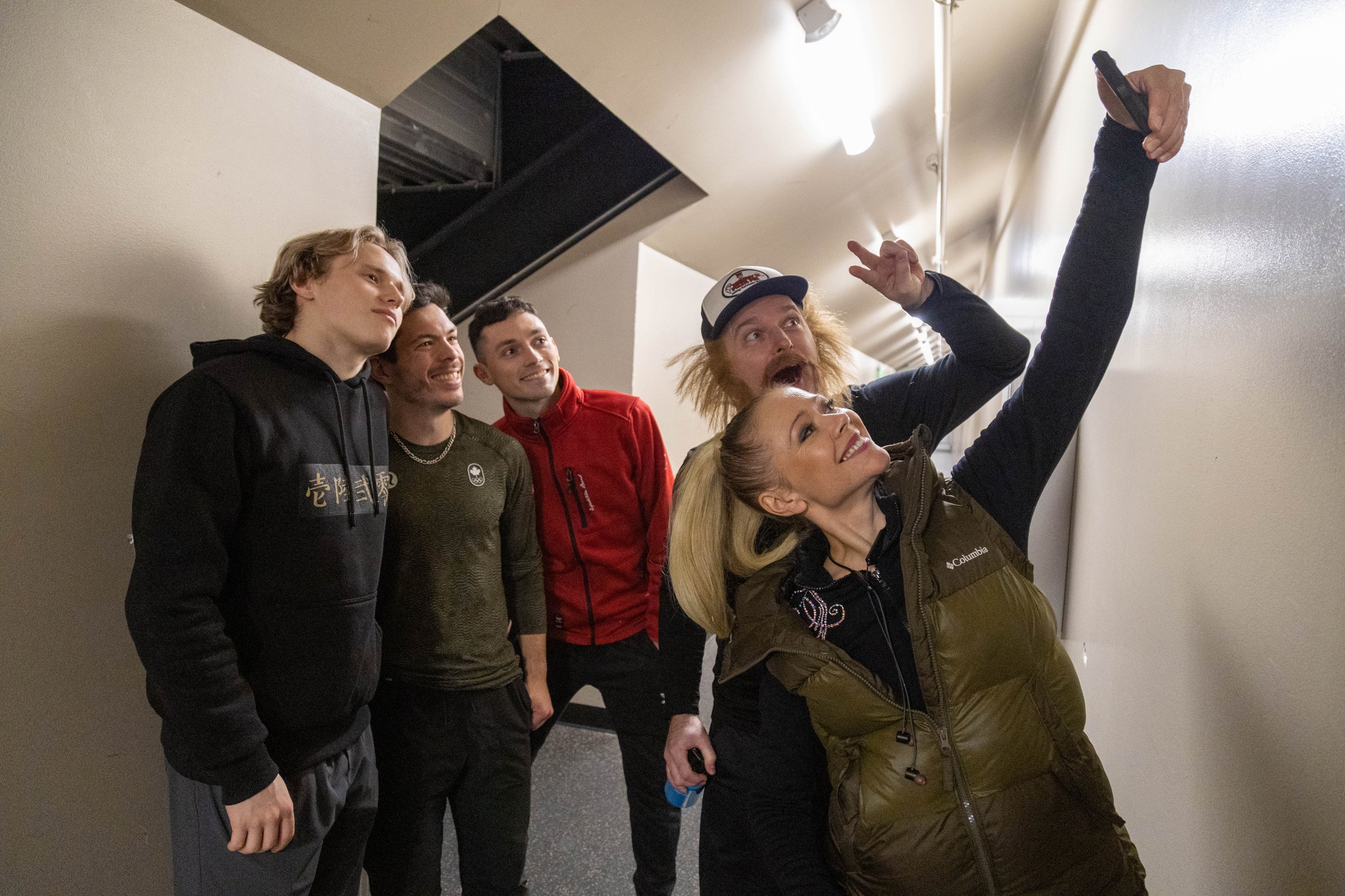
But to describe his jumps as effortless is to ignore the technique he’s been honing since it was taught to him—starting with his liftoff. “The friction between your blade and the ice melts you into the ice ever so slightly, and even some people at a high level will fight against that,” Weir explains, adding that Malinin “uses his edges, that friction of the blade to, in a weird way, make himself one with the ice. So when he launches, he’s not struggling to jump off a slippery surface. He’s carving deeper edges to get up.”
Once Malinin is airborne, Weir continues, “his rotating position stands out. There is no air that gets under his elbows, and no air that gets between his legs.” The visual effect is that of a tightly spinning top. “The smaller you make yourself,” Weir says, “the faster you spin.”
According to a 2018 Quartz article, skaters must spin faster than 400 rotations a minute—about half the rate of the tires on a car going 60 miles per hour—to complete the necessary 1,440 degrees in a standard quad jump. Landings subject them to impact forces several times their body weight. Fall and injury risk goes up—just practicing the jumps regularly puts additional wear and tear on their bodies.
In 1978, Canadian skater Vern Taylor landed the first triple Axel in men’s figure skating. More than 40 years later, the idea of someone adding an additional spin to that jump was still considered impossible enough that the Washington Post dedicated a triple-bylined story—complete with impressively animated visuals—to detailing how legendary Japanese skater Yuzuru Hanyu had nearly landed a quadruple Axel at the 2022 Beijing Games.
Unlike its fellow quad jumps—the toe loop, the Salchow, the flip, the loop, and the Lutz—the Axel is unique because skaters must take off while moving forward, yet land facing backward, meaning that it really demands four and a half rotations instead of four. But Malinin whirled his way into the record books when he landed the first one ever at a competition, in Lake Placid in September 2022 on the very first jumping pass of his free skate. Returning home after the event, he was feted with a small celebration in the party room overlooking SkateQuest’s rink, featuring a frosted sheet cake that read “Congratulations ILIA History HAS Been MADE #QUADG0D.”
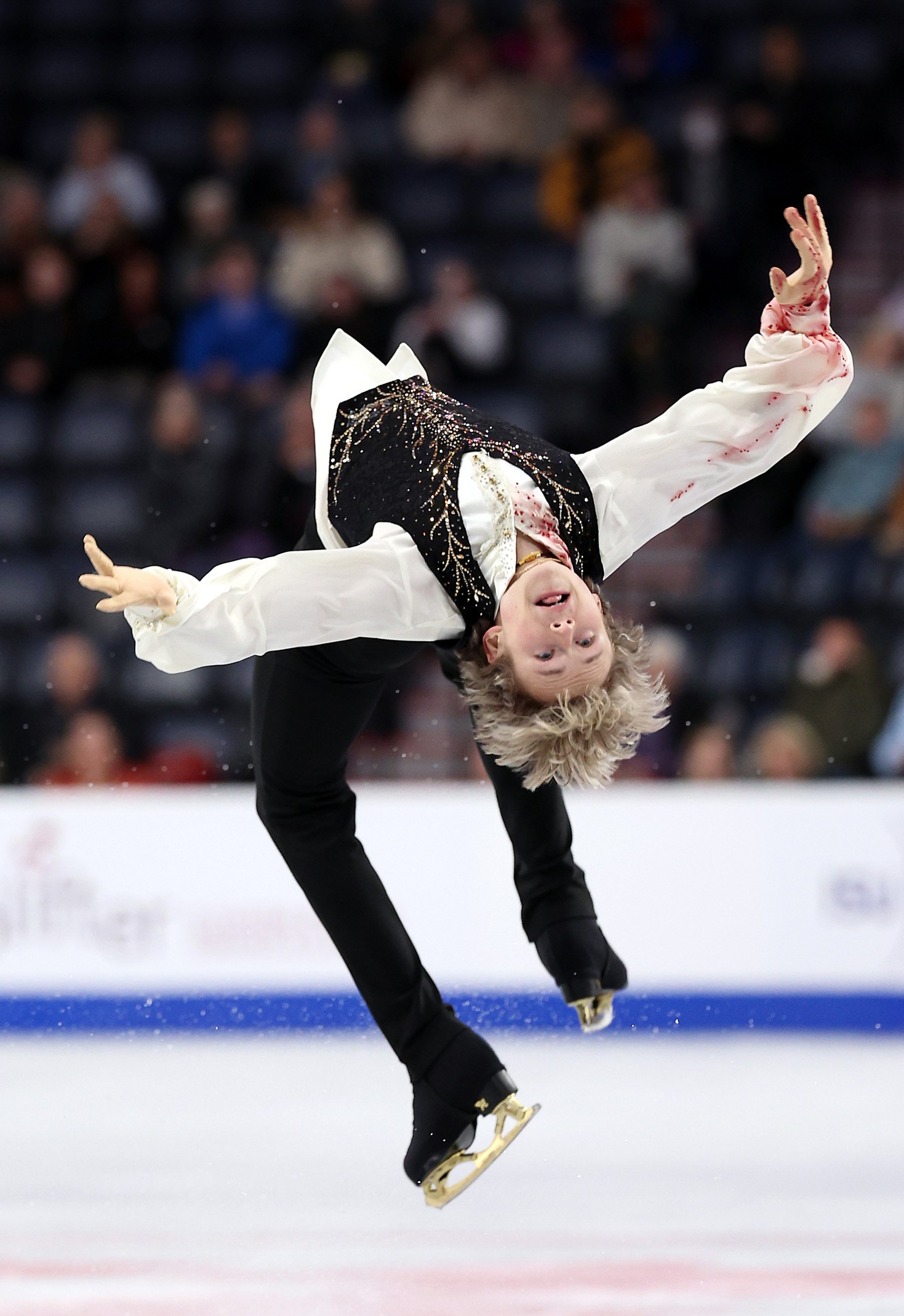
A month later, Malinin landed another perfectly rotated quad Axel—and has since continued to expand the sport’s limits. He added the recently re-legalized backflip to his free-skate program on the 2024 Grand Prix circuit, and landed one at the most recent US championships to punctuate a free skate that included a record-tying six quad jumps. He’s also invented his own trick, titled the “raspberry twist,” in which he horizontally somersaults through the air, his body virtually parallel to the ice, as though executing a wheeling roundhouse kick. (His mother’s surname, Malinina, translates from Russian to “raspberry.”)
“There’s no tangible scoring value for the raspberry twist—that’s what makes it unique,” says Mark Hanretty, a commentator for ISU’s world feed. “I think what makes me respect it all the more is he’s done something that won’t necessarily give him points but will excite an audience and cause people to think about what more is possible.”
What’s ultimately possible for Malinin on the ice? The answer may lie in his gala exhibitions. Held amid the deep exhale after the completion of scored routines, these performances allow athletes to truly put the “free” in “free skate.” They’re a time to try new tricks, to rock fun looks, to perform purely for themselves and their peers—and not for picky judges.
Hanretty, a former professional ice dancer, recalls two of Malinin’s gala performances from last year. In the first, following the 2024 Worlds, Malinin sported a hoodie and blue jeans in a dance set to “Hope” by the rapper NF, a song about overcoming inner struggles. “It was so contemporary and abstract,” Hanretty says. In the other, at the Grand Prix Final, Malinin offered an equally emotional routine—this time with Billie Eilish’s “Lonely” as the music—that concluded in an arching, twirling, classic layback spin.
“To be the world champion takes so much commitment to the competitive aspect of his career, so to see him devote so much time, space, and thought to being creative and out-of-the-box gave me a deeper appreciation of where Ilia might take things,” Hanretty says.
The best and most beloved skaters have always blended artistry and technical skill. You show what you can do, and also what you feel. “Especially boys, at a younger age, for them it’s cool to jump,” Flade says. “Then they grow older and they realize there’s more to it than jumping, and they start to enjoy that upper part of skating—the choreography, building programs, telling a story on the ice.”
Flade says Malinin has been maturing as a performer—lately, he’s been performing a free skate set to “I Am Not a Vampire” by the rock band Falling In Reverse, skating in a white shirt stained with streaks of fake blood while portraying a character wrestling with inner darkness.
Malinin says he’s also matured off the ice since April 2023, when he “stir[red] tension,” as a USA Today headline put it, for replying to a question on a live stream about his sexual orientation by suggesting that LGBTQ+ skaters received higher scores for the artistic components of their performances: “I gotta say I’m not straight—that way, my components are gonna go up.”
Malinin quickly apologized on social media and was encouraged to attend sensitivity training by the sport’s national governing body. “I wouldn’t say I was young, because I was 18 when I said it, but I would consider myself immature,” he says now. “I took in a lot from that. It was time for me to grow up.”
lite skating requires sacrifice. Malinin, who turned 20 in December, generally trains six days a week and an average of five to six hours on those days. He finished high school without attending a single prom or homecoming dance. He loves cycling, skateboarding, and trampolining—but has to stay away from all three around major competitions. “To not get injured,” he says.
Malinin and his family have worked to maintain a sense of normalcy. He still lives at home in Vienna. He remained in public school through graduation and enrolled at Mason last fall. This semester, he’s taking two online classes, business calculus and introduction to world history. “For now, that’s all I can really manage with my busy schedule,” he says. “But overall, I think it’s really fun for me, just to stay in education and to still be part of that Mason community.”
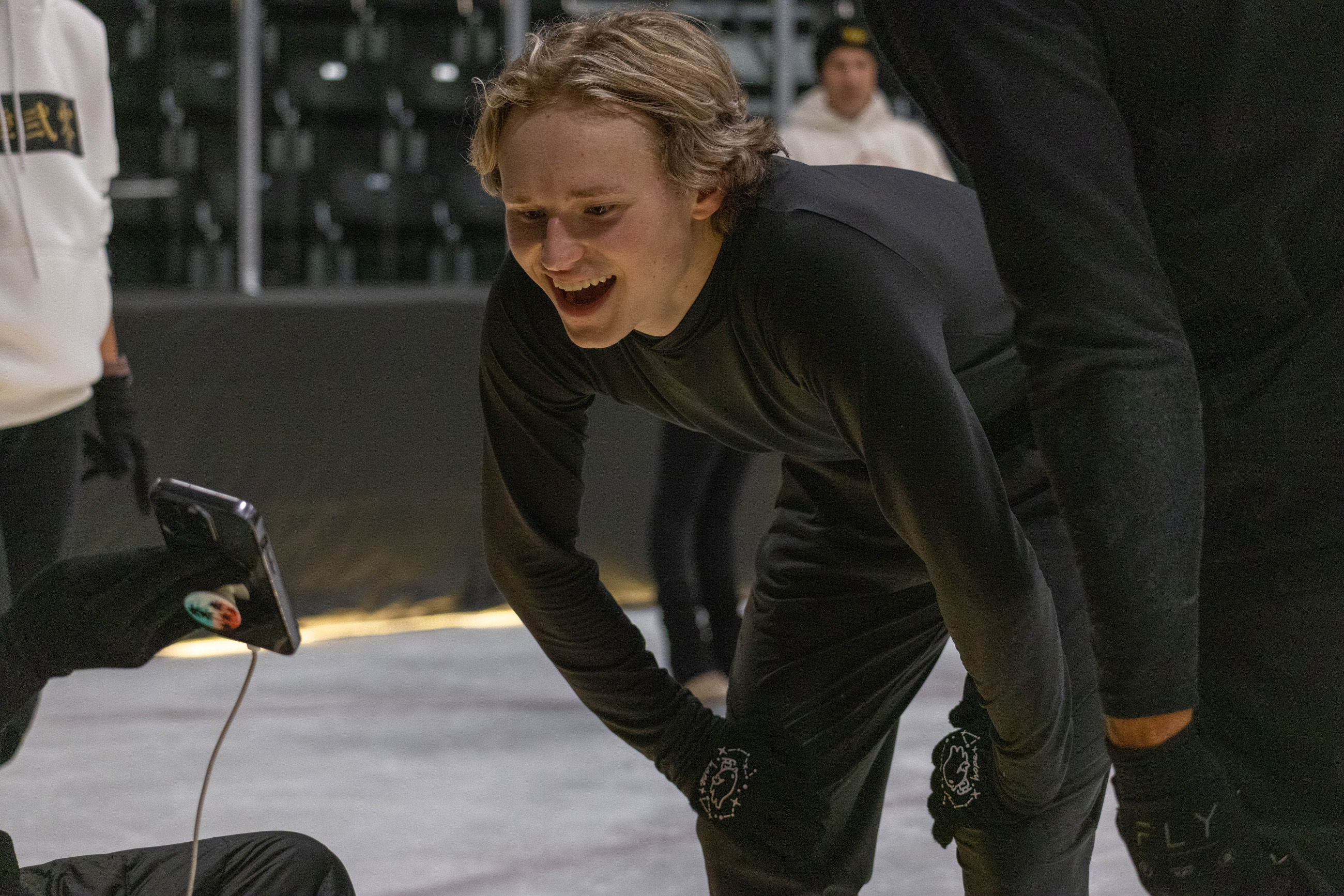
Fame is coming fast. Malinin says he’s been getting recognized more and more—not just in his neighborhood or on video game servers. “Even going to other states or other countries,” he says. “One day, I was at a Walmart or a Target and people were like, ‘You’re that figure skater.’ ” These kinds of encounters, Malinin admits, can be “kind of awkward, but it’s fun to know that a lot of people know me now.”
While he currently has fewer than a quarter million Instagram followers and only about 27,000 on TikTok, a strong performance at next year’s Winter Games is bound to send those numbers skyrocketing—and to boost his endorsement portfolio, currently headlined by a Japanese company that produces magnetic necklaces purporting to increase blood flow. “It’s going to be massive,” Weir says of the 2026 Olympics. “It will be a Simone Biles kind of storybook, in the way he has revolutionized our sport. Everyone thinks he can win gold.”
Malinin wants more. He has twice tried—and twice failed, so far—to land seven quad jumps in competition. He’s thinking about creating what he calls an almost “comedic program” for his Winter Games gala exhibition. He wants to design his own clothes, “not just for on the ice but for formal greetings or banquets or any other events.”

In practice, Malinin has even been working on a quintuple jump, a field-lapping innovation that, coming from him, sounds both fantastical and inevitable. “I really want to do it, so I think I have to approach it the same way I approached the quad Axel,” he says. “No one had landed a successful quad Axel at the time, so it was going into new territory, trying to figure out how to land it, how to make it the most consistent. I have to make sure my technique with the quints is on point. Right now it’s a little iffy because I’m all focused on my competitive programs—but once that’s over, I think I can really get fully involved into it.”
Last year, Malinin spoke to Flade for the German figure-skating magazine Pirouette, telling her that the celebrity he’d most like to meet, living or dead, was Albert Einstein. A big reason, he elaborated, was that he wanted to ask the revolutionary physicist how he felt about “all the new discoveries that people have made” since his era.
It’s easy to imagine some future skater wondering the same thing about Malinin. If that happens, he’ll be satisfied. For all his talk of matching the cultural impact of Messi and The Rock, Malinin isn’t trying to escape his sport. He’s trying to elevate it. “I want to inspire other athletes and push them to make figure skating bigger, or to make it more entertaining for people to watch,” he says. “It might be a long way to go, because of how much skating is now considered a small sport. But if everything goes the way I want it to, I hope that figure skating will become really popular again.”
It’s a lofty goal—but the Quadg0d isn’t afraid of bold leaps.
A Heartbreaking Loss
As this article was being prepared for publication, American Airlines Flight 5342 collided with an Army helicopter over the Potomac River, killing all 67 aboard both aircraft. According to US Figure Skating, 28 victims were members of the skating community, mostly from clubs in the Boston and DC areas and returning from the US championships in Wichita. Among them were Russian-born coaches and former 1994 pairs world champions Evgenia Shishkova and Vadim Naumov–whose son, Maxim, had already flown home safely after finishing fourth in the competition won by Ilia Malinin. Following the crash, Malinin told USA Today that his family knew Maxim’s parents “for a really long time” and that the crash was “heartbreaking” and “devastating.” US Figure Skating subsequently announced a March 2 exhibition event at Capital One Arena to raise relief funds; proceeds will go to the US Figure Skating Family Support Fund, the Greater Washington Community Foundation’s DCA Together Relief Fund, and the DC Fire & EMS Foundation.
The virtual battles waged in the online video games Fortnite and Valorant hardly constitute holy wars. But every so often, the sight of a certain screen name—“Quadg0d,” with the number replacing the vowel—can inspire fellow players to acknowledge a self-proclaimed deity in their midst.
“I’ve been really impressed,” says Ilia Malinin, none other than the Quadg0d himself. “Especially on the East Coast servers, a lot of random people will be like, ‘Omigosh, you’re that figure skater.’ ”
If anybody deserves such a title, it’s Malinin. A lifelong Northern Virginia resident and current George Mason University student, the 20-year-old is taking his sport to new heights—literally. In late January, Malinin ran away with his third straight gold in men’s singles at the United States Figure Skating Championships, a feat matched by only two other skaters since the turn of the century. He’s the favorite to capture a second consecutive world title in Boston in early March and should enter next year’s Winter Olympics in Milan-Cortina in the same position.

What sets Malinin apart isn’t just his victories. It’s the way he’s earned them, exhibiting unprecedented skill at quadruple jumps—the spinning, soaring, spectacular flights that require at least four midair rotations and have already vaulted him into figure-skating history. He’s the only skater ever to successfully pack all six globally ratified quad jumps into a single free-skate program, a feat that helped him repeat as champion of the International Skating Union’s Grand Prix last December. He’s also the only skater to stick the quad Axel—universally regarded as the toughest of those six jumps—in competition. While few others have dared to attempt that jump, Malinin has pulled it off with perfect rotation ten times since 2022, most recently during his free skate at the US championships.
All in all, not bad for someone who graduated from George C. Marshall High School in 2023—and just got around to obtaining his driver’s license a little over a year ago.
It’s a special person who can break the mold of figure skating. Not just because they win but because they change the whole sport.
“Those are things I never thought I’d see in my lifetime,” says NBC commentator and retired skater Johnny Weir. “It’s a special person who can break the mold of figure skating and really become a legend. Not just because they win but because they change the whole sport.”
Malinin seems well on his way to doing just that—helping to further a so-called “quad revolution,” in which skaters are increasingly attempting spectacular, physically punishing jumps once considered too difficult and dangerous. But his ultimate goal is even loftier. In the US, figure skaters have rarely achieved stardom outside their sport. Some, such as Olympians Brian Boitano and Michelle Kwan, have become famous, but almost wholly for their on-ice accomplishments. Malinin believes he can execute a different sort of leap.
“I think in the past, my sole focus was to be a skater and really be successful at skating,” he says. “Now I’m trying to become more than just a skating celebrity. I want to be one of the top celebrities in the world—like Cristiano Ronaldo, [Lionel] Messi, Dwayne Johnson. I want to be on that level.”
n the beginning, before the Quadg0d, there was Lutzboy.
During an illustrious career that featured a pair of Olympic appearances for Uzbekistan in 1998 and 2002, Russian-born Tatiana Malinina was particularly famous for her triple Lutz. Named for its inventor, Austrian skater Alois Lutz, the jump is especially “tricky because the takeoff is from the outside edge,” says Tatjana Flade, a journalist from Germany who has covered figure skating for more than three decades. “Many skaters don’t have a clean Lutz because their edge is not very clean on the outside.”
Years later, when it came time for Malinina’s eldest child to choose a social-media handle, young Ilia opted to pay homage to her. “I had her technique, and everyone was saying my Lutz was really good, so that’s what the user name was: Lutzboy,” says Malinin, who was born in 2004.
Initially, Malinina and husband Roman Skorniakov—also a two-time Olympian for Uzbekistan in Nagano and Salt Lake City—balked at the idea of training Ilia to follow in their skate-steps. They introduced him to the ice early on, with Ilia taking his first strides around age six, the same as Malinina once did under the tutelage of her father, a figure-skating coach in Russia. But their experience as elite competitors made them wary of pushing any further. “This takes so much time, dedication, a lot of sacrificing, so much hard work,” Malinina told ISU commentator Ted Barton in a video interview late last year. “And we thought maybe we want him to experience [a] different life than we had.”
This hands-off approach was perfectly fine with their son, at least for a bit. Rather than drill his edges or hone his takeoffs, Malinin preferred to freestyle at Reston’s SkateQuest, where both his parents work as coaches. “I’d just play different music over the loudspeakers and try to come up with random programs and enjoy skating for what it is,” he says. “It was just a fun hobby. I wasn’t thinking about doing it professionally.”
That changed quickly. Representing the Washington Figure Skating Club in the juvenile boys’ division at the 2015 US Figure Skating Championships, a ten-year-old Malinin placed ninth out of 12 entrants. The following year—while taking a break from his studies at public school in Fairfax to attend—he won gold. In 2020, he made his World Junior Championships debut in Tallinn, Estonia. It was there that Flade, the German journalist, first watched him compete.
“There were three Americans, and all three were the kids of former skaters,” Flade says. “He was the smallest of them, and he finished the lowest. But still he stood out, because you could see he was very confident.” Even after placing a middling 16th, Malinin expressed high hopes for his future during a post-skate interview with Flade and other journalists. “I remember vividly, we asked what his goals were, and he said that he’d like to make the 2022 Olympic team,” Flade says.
Seven months later, kicking off the season’s ISU Grand Prix at the 2020 Skate America event in Las Vegas, Malinin stuck his first two sanctioned quadruple jumps—the quad toe loop and the quad Salchow—in his senior debut. It was enough to motivate him to ditch @Lutzboy in favor of something unabashedly aspirational. “Everyone kind of got angry at me, like, ‘Why’d you name yourself Quadg0d? You only landed two quads,’ ” he says. “And I was like, ‘Well, I guess now it’s time for me to land the rest of them.’ The username was my motivation.”
More motivation arrived in early 2022 when a 17-year-old Malinin earned a surprise silver medal in the US Championships in Nashville, positioning himself for a possible spot on Team USA for the Beijing Olympics. Soon after, however, he was informed that the US would be bringing three veterans—Nathan Chen, Vincent Zhou, and Jason Brown—and that he’d be an alternate. At the time, Malinin says, he was “pretty, pretty pissed off with myself and annoyed,” blaming his omission on previous competition that season in which he skated particularly poorly.
Looking back, however, he sees his omission as a blessing in disguise: “I think that if I went to the Olympics, then I would not be where I am now. Not going really pushed me to view the sport a different way, and to really push my own physical and mental limits of where I can take this.”
eir first saw Malinin skate in person in spring 2016, at an exhibition Weir was hosting at his home rink in Wilmington, Delaware. “He was already doing triple Axels, which was so impressive,” Weir says of Malinin, then 12. “This fearless bravery [with which] he flies around the ice and hurls himself into the air—he had that then, and he still has that quality now.”
Given the intense physical and emotional tension that accompanies every jump—one missed edge, one under- or over-rotation, one failed landing and a skater’s score goes kaput—Malinin’s attitude is rare. “It’s a hard thing to be in a sport that’s so serious and have everything you’ve done come down to six minutes and still keep that playful frivolity,” says Weir, referring to the combined length of a skater’s short (two minutes) and long (four) programs. “It makes him an enchanting performer.”
It’s a hard thing to be in a sport that’s so serious and have everything you’ve done come down to six minutes and still keep that playful frivolity.
Malinin can seem almost casual as he goes about his history-making business. His self-described “lucky charm” is a soccer ball that he ritually juggles like a Hacky Sack as a warm-up. He has no problem peeking at the monitors backstage during competitions—in fact, he enjoys watching fellow skaters, even when he has yet to take the ice himself. “Not everyone’s like that,” Flade says. “Some even cover their ears so they don’t hear the other scores.” It also isn’t unusual to see Malinin lip-synching in the middle of his programs as he loses himself in the soundtrack—just as he used to back at SkateQuest as a kid. “When I’m able to get into that zone, then I’m able to really let all my emotions go,” Malinin says. “That helps me perform better.”

But to describe his jumps as effortless is to ignore the technique he’s been honing since it was taught to him—starting with his liftoff. “The friction between your blade and the ice melts you into the ice ever so slightly, and even some people at a high level will fight against that,” Weir explains, adding that Malinin “uses his edges, that friction of the blade to, in a weird way, make himself one with the ice. So when he launches, he’s not struggling to jump off a slippery surface. He’s carving deeper edges to get up.”
Once Malinin is airborne, Weir continues, “his rotating position stands out. There is no air that gets under his elbows, and no air that gets between his legs.” The visual effect is that of a tightly spinning top. “The smaller you make yourself,” Weir says, “the faster you spin.”
According to a 2018 Quartz article, skaters must spin faster than 400 rotations a minute—about half the rate of the tires on a car going 60 miles per hour—to complete the necessary 1,440 degrees in a standard quad jump. Landings subject them to impact forces several times their body weight. Fall and injury risk goes up—just practicing the jumps regularly puts additional wear and tear on their bodies.
In 1978, Canadian skater Vern Taylor landed the first triple Axel in men’s figure skating. More than 40 years later, the idea of someone adding an additional spin to that jump was still considered impossible enough that the Washington Post dedicated a triple-bylined story—complete with impressively animated visuals—to detailing how legendary Japanese skater Yuzuru Hanyu had nearly landed a quadruple Axel at the 2022 Beijing Games.
Unlike its fellow quad jumps—the toe loop, the Salchow, the flip, the loop, and the Lutz—the Axel is unique because skaters must take off while moving forward, yet land facing backward, meaning that it really demands four and a half rotations instead of four. But Malinin whirled his way into the record books when he landed the first one ever at a competition, in Lake Placid in September 2022 on the very first jumping pass of his free skate. Returning home after the event, he was feted with a small celebration in the party room overlooking SkateQuest’s rink, featuring a frosted sheet cake that read “Congratulations ILIA History HAS Been MADE #QUADG0D.”

A month later, Malinin landed another perfectly rotated quad Axel—and has since continued to expand the sport’s limits. He added the recently re-legalized backflip to his free-skate program on the 2024 Grand Prix circuit, and landed one at the most recent US championships to punctuate a free skate that included a record-tying six quad jumps. He’s also invented his own trick, titled the “raspberry twist,” in which he horizontally somersaults through the air, his body virtually parallel to the ice, as though executing a wheeling roundhouse kick. (His mother’s surname, Malinina, translates from Russian to “raspberry.”)
“There’s no tangible scoring value for the raspberry twist—that’s what makes it unique,” says Mark Hanretty, a commentator for ISU’s world feed. “I think what makes me respect it all the more is he’s done something that won’t necessarily give him points but will excite an audience and cause people to think about what more is possible.”
What’s ultimately possible for Malinin on the ice? The answer may lie in his gala exhibitions. Held amid the deep exhale after the completion of scored routines, these performances allow athletes to truly put the “free” in “free skate.” They’re a time to try new tricks, to rock fun looks, to perform purely for themselves and their peers—and not for picky judges.
Hanretty, a former professional ice dancer, recalls two of Malinin’s gala performances from last year. In the first, following the 2024 Worlds, Malinin sported a hoodie and blue jeans in a dance set to “Hope” by the rapper NF, a song about overcoming inner struggles. “It was so contemporary and abstract,” Hanretty says. In the other, at the Grand Prix Final, Malinin offered an equally emotional routine—this time with Billie Eilish’s “Lonely” as the music—that concluded in an arching, twirling, classic layback spin.
“To be the world champion takes so much commitment to the competitive aspect of his career, so to see him devote so much time, space, and thought to being creative and out-of-the-box gave me a deeper appreciation of where Ilia might take things,” Hanretty says.
The best and most beloved skaters have always blended artistry and technical skill. You show what you can do, and also what you feel. “Especially boys, at a younger age, for them it’s cool to jump,” Flade says. “Then they grow older and they realize there’s more to it than jumping, and they start to enjoy that upper part of skating—the choreography, building programs, telling a story on the ice.”
Flade says Malinin has been maturing as a performer—lately, he’s been performing a free skate set to “I Am Not a Vampire” by the rock band Falling In Reverse, skating in a white shirt stained with streaks of fake blood while portraying a character wrestling with inner darkness.
Malinin says he’s also matured off the ice since April 2023, when he “stir[red] tension,” as a USA Today headline put it, for replying to a question on a live stream about his sexual orientation by suggesting that LGBTQ+ skaters received higher scores for the artistic components of their performances: “I gotta say I’m not straight—that way, my components are gonna go up.”
Malinin quickly apologized on social media and was encouraged to attend sensitivity training by the sport’s national governing body. “I wouldn’t say I was young, because I was 18 when I said it, but I would consider myself immature,” he says now. “I took in a lot from that. It was time for me to grow up.”
lite skating requires sacrifice. Malinin, who turned 20 in December, generally trains six days a week and an average of five to six hours on those days. He finished high school without attending a single prom or homecoming dance. He loves cycling, skateboarding, and trampolining—but has to stay away from all three around major competitions. “To not get injured,” he says.
Malinin and his family have worked to maintain a sense of normalcy. He still lives at home in Vienna. He remained in public school through graduation and enrolled at Mason last fall. This semester, he’s taking two online classes, business calculus and introduction to world history. “For now, that’s all I can really manage with my busy schedule,” he says. “But overall, I think it’s really fun for me, just to stay in education and to still be part of that Mason community.”

Fame is coming fast. Malinin says he’s been getting recognized more and more—not just in his neighborhood or on video game servers. “Even going to other states or other countries,” he says. “One day, I was at a Walmart or a Target and people were like, ‘You’re that figure skater.’ ” These kinds of encounters, Malinin admits, can be “kind of awkward, but it’s fun to know that a lot of people know me now.”
While he currently has fewer than a quarter million Instagram followers and only about 27,000 on TikTok, a strong performance at next year’s Winter Games is bound to send those numbers skyrocketing—and to boost his endorsement portfolio, currently headlined by a Japanese company that produces magnetic necklaces purporting to increase blood flow. “It’s going to be massive,” Weir says of the 2026 Olympics. “It will be a Simone Biles kind of storybook, in the way he has revolutionized our sport. Everyone thinks he can win gold.”
Malinin wants more. He has twice tried—and twice failed, so far—to land seven quad jumps in competition. He’s thinking about creating what he calls an almost “comedic program” for his Winter Games gala exhibition. He wants to design his own clothes, “not just for on the ice but for formal greetings or banquets or any other events.”

In practice, Malinin has even been working on a quintuple jump, a field-lapping innovation that, coming from him, sounds both fantastical and inevitable. “I really want to do it, so I think I have to approach it the same way I approached the quad Axel,” he says. “No one had landed a successful quad Axel at the time, so it was going into new territory, trying to figure out how to land it, how to make it the most consistent. I have to make sure my technique with the quints is on point. Right now it’s a little iffy because I’m all focused on my competitive programs—but once that’s over, I think I can really get fully involved into it.”
Last year, Malinin spoke to Flade for the German figure-skating magazine Pirouette, telling her that the celebrity he’d most like to meet, living or dead, was Albert Einstein. A big reason, he elaborated, was that he wanted to ask the revolutionary physicist how he felt about “all the new discoveries that people have made” since his era.
It’s easy to imagine some future skater wondering the same thing about Malinin. If that happens, he’ll be satisfied. For all his talk of matching the cultural impact of Messi and The Rock, Malinin isn’t trying to escape his sport. He’s trying to elevate it. “I want to inspire other athletes and push them to make figure skating bigger, or to make it more entertaining for people to watch,” he says. “It might be a long way to go, because of how much skating is now considered a small sport. But if everything goes the way I want it to, I hope that figure skating will become really popular again.”
It’s a lofty goal—but the Quadg0d isn’t afraid of bold leaps.
A Heartbreaking Loss
As this article was being prepared for publication, American Airlines Flight 5342 collided with an Army helicopter over the Potomac River, killing all 67 aboard both aircraft. According to US Figure Skating, 28 victims were members of the skating community, mostly from clubs in the Boston and DC areas and returning from the US championships in Wichita. Among them were Russian-born coaches and former 1994 pairs world champions Evgenia Shishkova and Vadim Naumov–whose son, Maxim, had already flown home safely after finishing fourth in the competition won by Ilia Malinin. Following the crash, Malinin told USA Today that his family knew Maxim’s parents “for a really long time” and that the crash was “heartbreaking” and “devastating.” US Figure Skating subsequently announced a March 2 exhibition event at Capital One Arena to raise relief funds; proceeds will go to the US Figure Skating Family Support Fund, the Greater Washington Community Foundation’s DCA Together Relief Fund, and the DC Fire & EMS Foundation.
This article appears in the March 2025 issue of Washingtonian.
